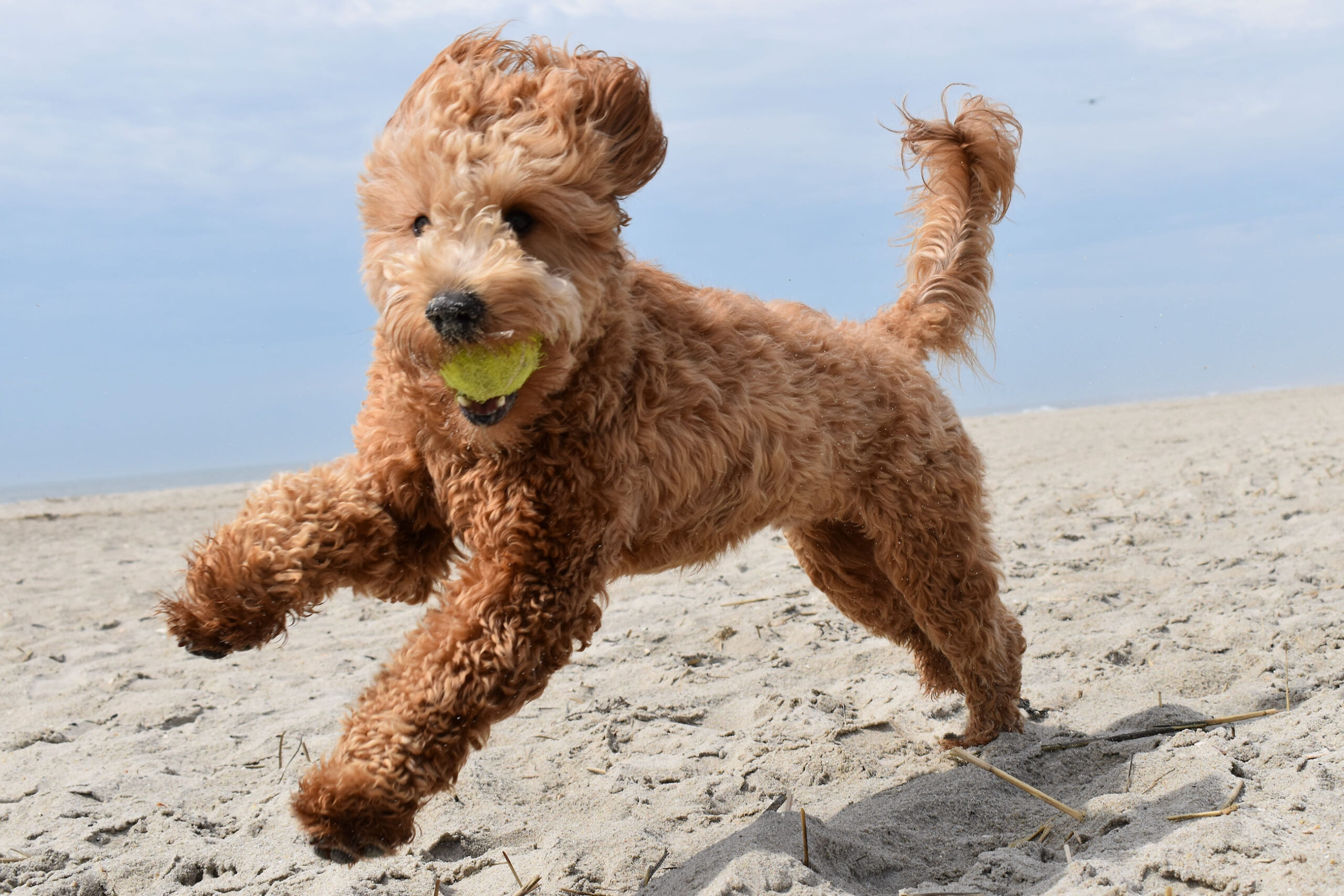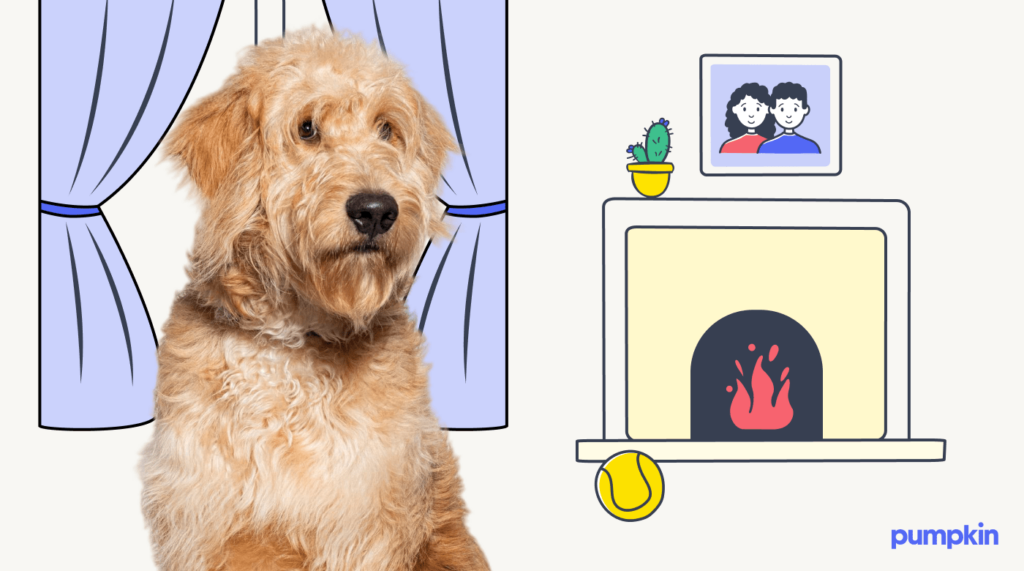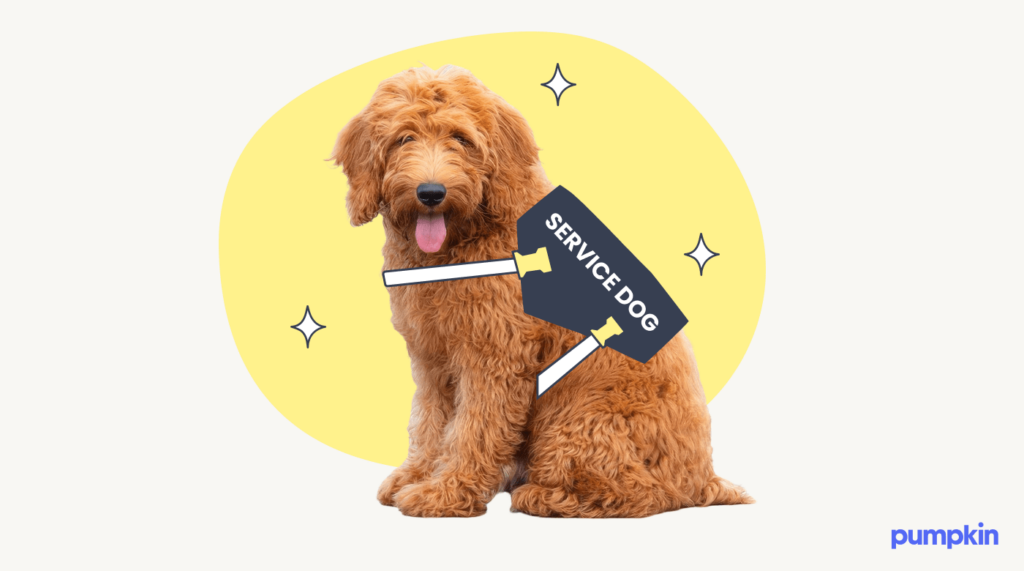Key Points
- Goldendoodles are a cross between two purebred breeds: a Golden Retriever and a Poodle.
- Goldendoodles can live up to 14 years, depending on their size.
- Thanks to their Poodle pedigree, Goldendoodles typically shed less than Golden Retrievers and are better suited for people with allergies.
- Goldendoodles have become extremely popular in recent years, both here in the U.S. and in the UK.
A Goldendoodle is what happens when a golden retriever and Poodle fall in love and decide to have the world’s fluffiest puppy.
They’re friendly, intelligent dogs that train easily and may become your new best friend if you suffer from dog allergies. With their irresistible charm, playful nature, and knack for winning hearts, it’s no wonder that they’ve become an extremely popular hybrid.
Goldendoodles’ parent breeds, Golden Retrievers and Poodles, are both among the AKC’s top 10 most popular breeds. (Because they’re produced by crossbreeding, the AKC considers the Goldendoodle a hybrid or designer breed.) They’re extremely popular here in the United States, and they’re also the most popular dogs in the United Kingdom.
They’re lovely family pets and service dogs. They can also be a bit mischievous, but they take well to dog training. So, what exactly makes this designer breed so appealing?
In this article, we’ll cover 12 must-know facts, including the Goldendoodle lifespan, size, common health problems, and much more!
1. Goldendoodles were first bred in 1989
Goldendoodles are actually a relatively new type of dog. Sometimes called a Groodle, the first modern Goldendoodle was bred in 1989 by Wally Conron of the Royal Guide Dog Association of Australia. Conron combined the Golden Retriever’s sunny disposition with the Poodle’s intelligence and propensity for low shedding.
They were kind, intelligent, and allergy-friendly.
Fun Fact: It’s claimed that Monica Dickens, the great-granddaughter of Charles Dickens, bred the first cross between a Golden Retriever and a Poodle in 1969. This hybrid didn’t become popular then, but it took off in the 1990s.
2. Goldendoodles are “hybrid” dogs
Hybrid or designer breeds result from controlled breeding between two purebred dog breeds.
Reputable breeders control the breeding and generations in their litter. They also test for genetic predispositions, common health issues between the breeds, and the relative health of their parents.
Since the Goldendoodle is a hybrid breed, many are first-generation, and these dogs are referred to as F1 Goldendoodles.
A puppy’s classification shows which breed mix or generation they come from. It’s relatively uncommon to breed two Goldendoodles together.
Goldendoodle classifications break down as follows:
- F1: Golden Retriever (50%) + Poodle (50%)
- F1B: Poodle (75%) + Goldendoodle (25%) (F1) This is the most allergy-friendly classification.
- F2: Goldendoodle (F1) + Goldendoodle (F1)
- Multigen: Goldendoodle + Goldendoodle (F1B, Multigen) or Poodle
3. Goldendoodles have a long lifespan
If you’re wondering, “How long do Goldendoodles live?” The answer is a long time. Pure-bred dogs often suffer from specific ailments, but hybrids are often spared from these breed-specific health problems.
Since this hybrid is healthier than their parent breeds, these dogs live an average of 10-14 years — sometimes even longer when following a good diet.
Vets attribute the long Goldendoodle lifespan to the benefits of “heterosis,” whereby mixing two unrelated breeds results in their offspring enjoying increased health benefits. This hybrid vigor allows the Goldendoodle to outlive both of its parent breeds.
The smaller your Goldendoodle, the longer its lifespan, on average. (This is also true with regular dog breeds: the larger the breed, the shorter the lifespan.)
You can do several things to increase the life expectancy of your Goldendoodle even more.
- Feed them a proper diet to help with weight management and provide nutrients for strong eye, bone, and skin health.
- Ensure they get regular exercise, playtime, and activities to increase their physical activity.
- Focus on their mental health with puzzle toys, training sessions, and interactive games to prevent boredom and reduce behavioral issues.
- Take them for yearly vet wellness checks to keep your pooch up to date with vaccinations, health screenings, and dental care.
Pet Pro Tip: Beyond unlimited access to a 24/7 Health Helpline, Pumpkin Wellness Club members can also get cash back and save up to $390/year on key routine preventive care services at any licensed vet, plus access to special discounts on top pet brands. Learn more about membership options.
4. Goldendoodles are not hypoallergenic

No dog is 100% hypoallergenic or non-shedding.
Contrary to common belief, allergic reactions result from exposure to pet dander, not fur. Dander comprises dead skin cells sloping off and gathering on the fur. Shedding releases dander and fur into the air, causing allergic reactions in dog allergy sufferers.
So, do Goldendoodles shed?
Due to the tightly curled hair that they get from their Poodle parents (as opposed to a typical coat of fur, which is distinct from hair), Goldendoodles are known to shed less. The tighter the curls, the less they shed. This means allergy sufferers may experience fewer allergy symptoms.
5. Goldendoodles are prone to some common health problems
Even though this breed is generally healthier than their parents, they can still have health problems.
The most common Goldendoodle health problems are:
- ACL injuries and ruptures
- Lameness and limping
- Vomiting or diarrhea
- Hip dysplasia – check for certification from the breeder
- Subvalvular aortic stenosis – check for certification from breeder
- Sebaceous adenitis – benign growths on the skin
- Eyelid entropion – eyelids curl inward and may require surgery
- Cataracts, glaucoma
- Ear infections
- Dental Disease
Checking your doodle’s parentage and finding reputable breeders can help narrow down the list of genetic health issues.
Of course, all dogs can have accidents or unexpected illnesses. When this happens, a Pumpkin dog insurance plan can help you focus on what’s best for your dog’s health.
6. Goldendoodles come in three sizes
The standard Goldendoodle is a cross between a Golden Retriever and a standard Poodle. However, once this dog became popular, breeders got requests for smaller, more versatile versions of the Doodle. The smallest doodles have a distinctly teddy bear-like appearance, which only makes these dogs more endearing.
So, they bred Golden Retrievers with Poodles of different sizes to make the breed more diverse without diluting the desired characteristics and personalities of the dogs. Now, Goldendoodles have three sizes:
- Miniature Goldendoodles: 13″-20” in height, 15-35 pounds
- Medium Goldendoodle: 16″-20” in height, 40-50 pounds
- Standard Goldendoodle: 20″-24” in height, 50-90 pounds
7. Goldendoodles are excellent family pets
Known for being happy, friendly, and intelligent, Goldendoodles are easy to train. (If you don’t train them, don’t be surprised if they help themselves to unattended food and chew up everything in sight.) They’re also very gentle and devoted to their family, including its younger members. This gregarious breed will charm the pants off your guests and eagerly take part in family activities.
They also get along with most other four-legged family members. They’re social butterflies that get along well with anyone they meet.

The downside of them being so social and bonded to their families is that they can suffer from separation anxiety. Leaving them alone for too long or keeping them separated from their family can cause them to experience anxiety and loneliness.
8. They have coats of many colors
The most common color for a Goldendoodle is golden, after its Golden Retriever parents. That said, many also have poodle colors.
They can be orange, apricot, cream, dark brown, gray, or black. Some even have multi-colored coats. The rarest are blue Goldendoodles, which require several years of breeding to achieve this tint.
Interestingly, they can also have different eye colors. Most have dark brown eyes, but there are Doodles with green eyes and sometimes even multicolored eyes (i.e. one brown and one blue or green).
9. Grooming them is relatively easy
A low-shedding coat means the Goldendoodle needs less grooming than many other dogs. Brush them every few days with a slicker brush to remove any loose hair and bathe them when needed. When your dog gets shaggy, have them clipped every eight weeks.
Doodles with straighter coats need more frequent brushing because they shed more, especially during the fall and spring, when dogs shed their coats.
Ear infections are common among Goldendoodles because of their floppy ears and the shape of their ear canals, both of which encourage bacteria to grow. When visiting the vet or groomer, ask them to check the hair inside your dog’s ears to reduce the chance of ear infections. Cleaning their ears at least once a week will also reduce the chance of infection.
10. Goldendoodles have low odor compared to other dogs
Another highly appealing trait of Goldendoodles is that they tend to have low odor compared to other dogs.
Their Poodle parent is also known for being a clean and low-odor breed. Poodles have hair instead of fur, which doesn’t trap as much oil or dander, leading to fewer smells.
11. Doodles need space to roam
Goldendoodles are companion dogs. They’re not meant to live alone, outdoors, or in kennels. If they need to live in apartments, they can be apartment dogs with the right environment enrichment.
But — and this is an important but — they fare better when they have space to roam. A fenced yard, regular exercise, and plenty of playtime with you will keep your Doodle happy and well-adjusted, no matter where you call home.
12. Goldendoodles love having jobs to do!
These very good dogs descend from hunting and water dogs. (There’s a reason Poodles have webbed feet.) They’re also in the working dog category, and that means they love having jobs to do. Easy to train, intelligent, and calm, Doodles are excellent service or therapy dogs.
They provide services as companion and PTSD dogs, leading visually impaired individuals, working as trauma and depression companions, and working alongside humans during search and rescue missions.

Many Goldendoodles are sniffer dogs, too, trained to sniff out disease or nuts and eggs in food. Some are trained to detect seizures before they happen or to alert diabetics when their blood sugar is dangerously low.
Even though they’re excellent service dogs, they’re terrible watchdogs or guard dogs. They’re lovers, not fighters, and would rather make friends than defend themselves or anything else.
Considerations when adopting or buying a Goldendoodle
Before you welcome a Goldendoodle into your family, here are some things to consider.
Genetic health testing
Check whether the Goldendoodle’s parents have undergone health testing. This can reveal any genetic health conditions that could be passed down. Responsible breeders should provide documentation of these tests.
Lifestyle compatibility
Consider how the Goldendoodle will fit in with your lifestyle. As mentioned, these dogs are very energetic and require a lot of playtime and attention. Think about whether your house or apartment has enough space for them to roam.
Time commitment
Owning a Goldendoodle requires a significant time commitment for training, grooming, and socialization. Be prepared to dedicate time to their appearance and health.
Allergies to dogs
While Goldendoodles are known to cause fewer allergies among humans, ensure none of your household members have severe dog allergies. A good way to determine this is to spend time around these dogs prior to getting one.
Ready to add a doodle to your family?
Goldendoodles are the ultimate family sidekick.
They have tons of energy, are super friendly, and are great with kids and other pets. And with the long Goldendoodle lifespan, they’ll be a cherished member of your family for many years to come. Especially if you feed them well and make sure they get plenty of exercise.
If you’re thinking about getting one (or multiple) Doodle puppies, consider talking to other Doodle parents first to learn more about these vivacious and lovable dogs.
FAQs about Goldendoodles
- https://www.akc.org/most-popular-breeds/
- https://www.archviewlabradoodles.com/about-labradoodles/breed-history/
- https://www.goldendoodleassociation.com/about-the-breed/history-of-the-goldendoodle/
- https://vcahospitals.com/know-your-pet/designer-dog-breeds
- https://goldendoodles.net/a-detailed-list-of-the-differences-in-goldendoodle-generations/
- https://goldendoodles.net/how-much-exercise-does-my-dog-need/
- https://content.tailster.com/goldendoodle-heart-disease/
- https://happydogbreeds.com/goldendoodle-growth-chart/
- https://www.britannica.com/science/heterosis
- https://goldendoodles.net/dealing-with-goldendoodle-separation-anxiety-24-handy-tips/
- https://www.merchantcircle.com/blogs/goldendoodle-world1-cleveland-nc/2020/8/Blue-eyed-Goldendoodles/176849
- https://www.niehs.nih.gov/health/topics/agents/allergens/pets
- https://vetericyn.com/blog/goldendoodle-ear-infections-treatment-prevention/
- https://www.dogster.com/lifestyle/do-all-dogs-have-webbed-feet
- https://vcahospitals.com/know-your-pet/aortic-stenosis-in-dogs
- https://www.mspca.org/angell_services/canine-sebaceous-adenitis/
- https://vcahospitals.com/know-your-pet/eyelid-entropion-in-dogs
- https://goldendoodles.net/how-long-do-goldendoodles-live/
- https://www.prideandprejudoodles.com/hyper-goldendoodle/
- https://www.theguardian.com/lifeandstyle/2024/feb/19/reign-of-goldendoodle-how-it-became-uk-top-dog
- https://www.usnews.com/insurance/pet-insurance/most-popular-dog-breeds-study




